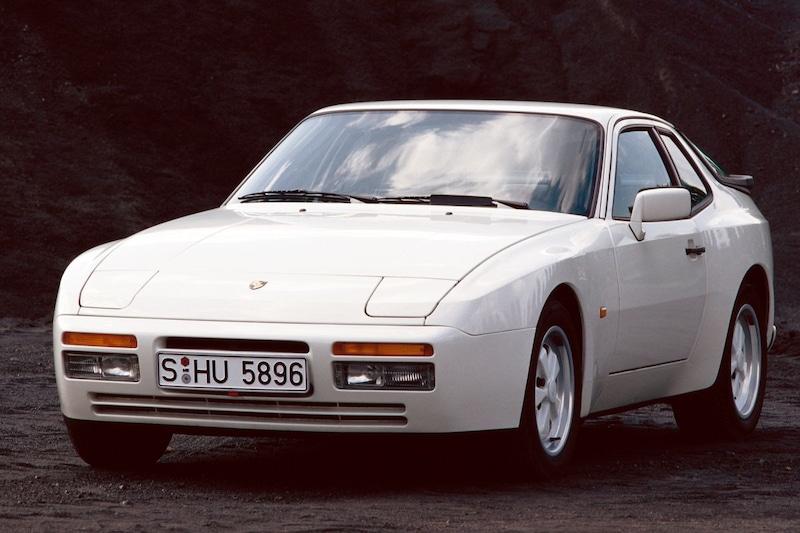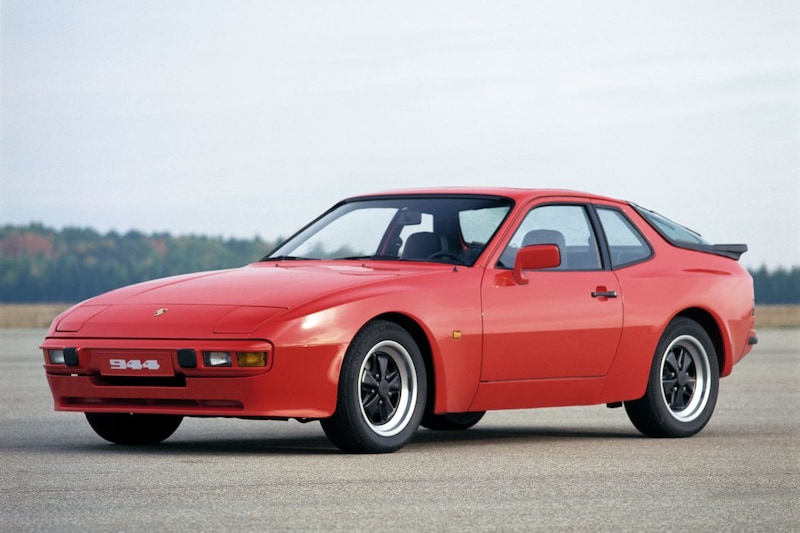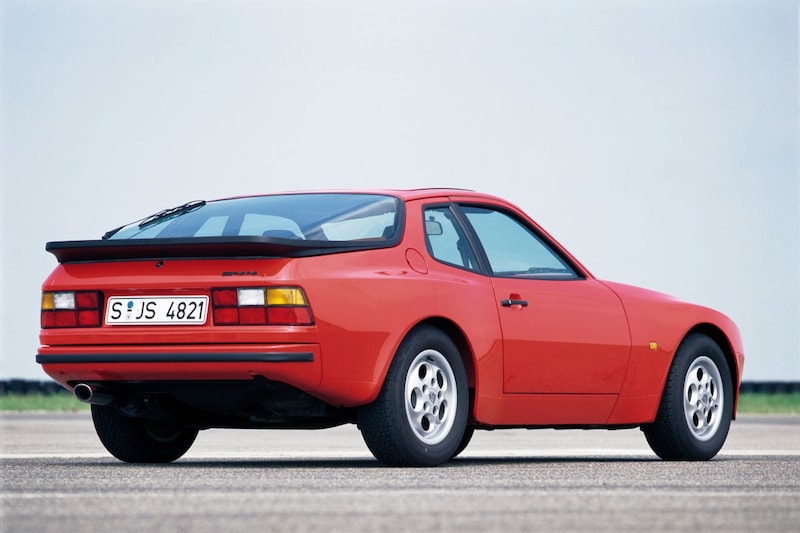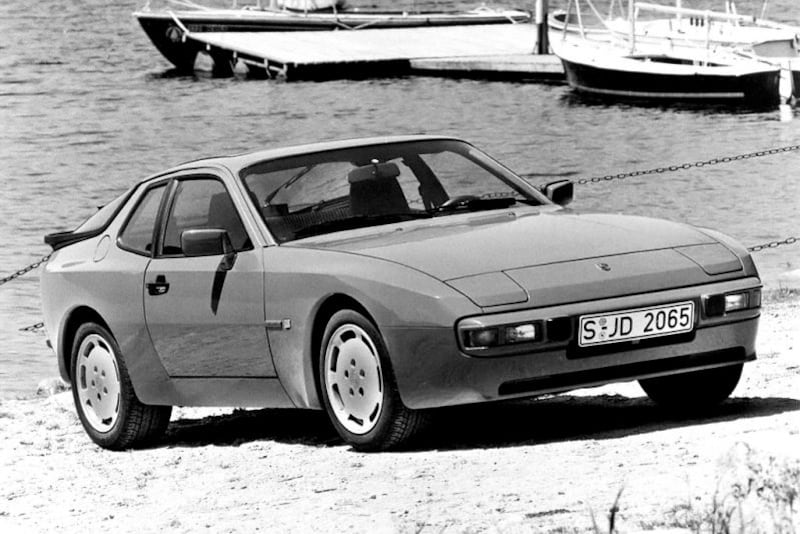One of the many toppers from 1982
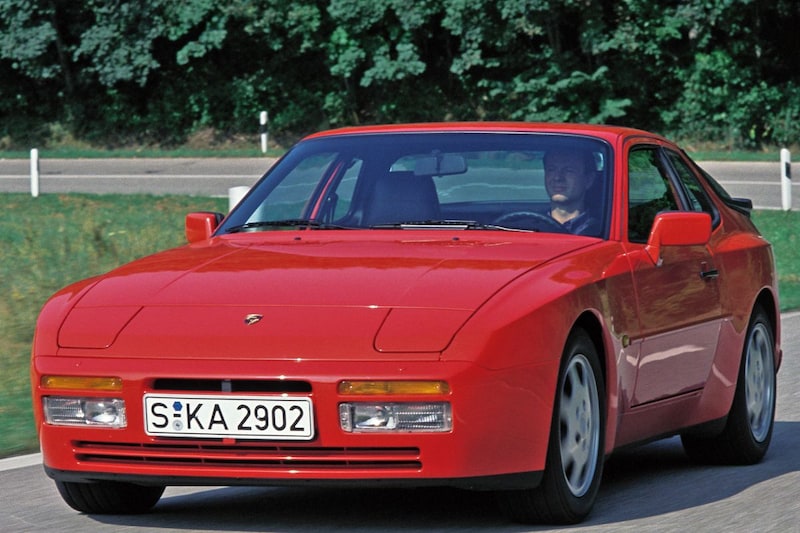

The Porsche 944 is one of those many toppers that made 1982 a fantastic car year. In this episode we look at the model that elaborated on the 924. But the 944 did become a real Porsche.
How revolutionary is the 944?
With the introduction of the 924 and a few years later the 928, Porsche changes course considerably; the brand has stuck to rear-mounted, air-cooled boxer engines since its inception. And now suddenly a liquid-cooled power source in the front and the gearbox at the rear, the transaxle principle. So the revolution is already underway, with the idea that the concept of the 911 is finite and Porsche is not making enough money to keep its head above water. To turn the 924 into a 944, it is immediately clear that another engine must be used. Porsche is considering Audi’s five-cylinder, but it doesn’t fit. Secretly, Porsche also hung the 2.7-liter V6 from Peugeot, Renault and Volvo in a 924, but that does not seem to be the solution either. In addition, the 911 also has a 2.7-liter six-cylinder in those years, and a little difference should remain. Although predecessor 924 does not even get bad reviews from the press and also sells well, the 944 can count on a lot of enthusiasm. Logical, because it looks more powerful with its extended fenders, has a much better chassis with disc brakes all around and of course a real Porsche engine. There is still a bit of criticism on the unchanged interior, in which you still see buttons and switches from Volkswagen.
What does the start-up process look like?
For the origin of the 944, we have to go back fifty years in time, when Porsche is commissioned by Volkswagen to develop a successor to the 914. Under the project name EA 425, a sports car designed by the Dutchman Harm Lagaay, based on technology from Volkswagen and Audi, is created. When the project is almost complete, Volkswagen pulls the crap and Porsche decides to buy all the rights. Thus the 924 was born. In its first two full sales years (1976 and 1977) it breaks all records, but in the eyes of the press and the public it remains a bit of a Volkswagen. That changes when the 944 follows at the end of 1981, with the engine as the most important innovation: half of the V8 from the 928, but with a larger bore (100 versus 95 mm), so that the displacement comes to 2.5 liters. This engine (163 hp and 205 Nm) also serves from 1986 to 1988 in the 924 S (150, later 160 hp). In appearance, the 944 is based on the 924 Carrera GT. Porsche initially offers only one engine variant for the 944, the new 2.5-liter four-cylinder. It is made entirely of light metal and equipped with two balance shafts to counteract vibrations. Funnily enough, Porsche has to knock on the door of Mitsubishi for this technology, which has held the patent for it since the 1970s. It applies the balance shafts in the four-cylinder of the Galant, among other things. The 944 comes standard with a five-speed manual transmission, but a three-speed automatic is available at an additional cost. Because there is no Targa or Cabriolet based on the 944, customers are offered the option of having a large, removable steel roof with a ventilation position fitted. A practical plus compared to the 911 is the large, glass tailgate in combination with folding rear backrests.
When the project is almost complete, Volkswagen pulls the crap and Porsche decides to buy all the rights. Thus the 924 was born. In its first two full sales years (1976 and 1977) it breaks all records, but in the eyes of the press and the public it remains a bit of a Volkswagen. That changes when the 944 follows at the end of 1981, with the engine as the most important innovation: half of the V8 from the 928, but with a larger bore (100 versus 95 mm), so that the displacement comes to 2.5 liters. This engine (163 hp and 205 Nm) also serves from 1986 to 1988 in the 924 S (150, later 160 hp). In appearance, the 944 is based on the 924 Carrera GT. Porsche initially offers only one engine variant for the 944, the new 2.5-liter four-cylinder. It is made entirely of light metal and equipped with two balance shafts to counteract vibrations. Funnily enough, Porsche has to knock on the door of Mitsubishi for this technology, which has held the patent for it since the 1970s. It applies the balance shafts in the four-cylinder of the Galant, among other things. The 944 comes standard with a five-speed manual transmission, but a three-speed automatic is available at an additional cost. Because there is no Targa or Cabriolet based on the 944, customers are offered the option of having a large, removable steel roof with a ventilation position fitted. A practical plus compared to the 911 is the large, glass tailgate in combination with folding rear backrests.
What are the competitors?
In 1982 you pay fl. 65,900 (€29,904) for the Porsche 944. To put this in perspective: the simplest Opel Kadett is listed for fl. 15,000. In fact, the 944 hardly has any competition. From our own house there is the 924 Turbo, which is fl. 5,600 more expensive. The only, somewhat equivalent sports car in 1982 is the Renault Alpine A310 V6. Indeed, with the six-cylinder engine that Porsche once considered. All other sports cars are more expensive (and faster), so that Porsche occupies an almost unique position in the market with the 944.
What does the consumer think?
Upon its introduction, the 944 is immediately well received by the public. The 944 is a car that only a select audience can afford. Critical customers, often. Can you present them a car that you can also describe as a facelift of a model that is more than seven years old? Still, Porsche pulls out enough to make the 944 attractive and significantly better than its predecessor. That produces good reviews and that translates into good sales figures. In the first year, 1982, Porsche can already record 30,000 orders. This will of course not remain the case and as the years progress, the interest continues to decline. After nine years, the production counter stops at 163,192 units.
 Any details about his life?
Any details about his life?
It takes a remarkably long time before Porsche comes up with a faster 944. Only in 1985 does the Turbo appear on the market, good for 220 hp and 330 Nm. That introduction is accompanied by the arrival of a completely new, much more modern dashboard. With this Porsche says goodbye to the three round clocks from the old 924. In 1986 the 944 S follows, with a sixteen-valve cylinder head and 190 hp. Another two years later, it is the turn of the 944 S2 with a 3.0-litre engine, at that time the largest four-cylinder in series production. That machine produces 211 hp and 280 Nm and we would later see it again in the Porsche 968. However, we are not there yet; the horsepower race continues and in 1989 the 944 Turbo kicks it to 250 horsepower, a new high. In other words: aside, 911 Carrera 3.2, because your more expensive and faster four-cylinder brother wants to pass! All this indicates that the transaxle models can no longer be counted as Porsche’s entry-level models at that time. In the meantime, the 2.5 from the 944 has been overhauled and the cylinder capacity grows to 2.7 liters. The power goes to 165 hp. It is still a while to wait for a convertible, even though a study model, built by Baur, shines at the IAA in 1985. Only in 1989 is the 944 S2 Cabriolet in the showroom; it is built by ASC (American Sunroof Company) in Weinsberg, Germany. Porsche delivers the body of the 944 Coupé to ASC, where they saw off the roof, apply the necessary reinforcements and mount a trunk lid. Then the coach returns to Neckarsulm. When the car is finished there, it goes back to ASC for installation of the fabric hood.
However, we are not there yet; the horsepower race continues and in 1989 the 944 Turbo kicks it to 250 horsepower, a new high. In other words: aside, 911 Carrera 3.2, because your more expensive and faster four-cylinder brother wants to pass! All this indicates that the transaxle models can no longer be counted as Porsche’s entry-level models at that time. In the meantime, the 2.5 from the 944 has been overhauled and the cylinder capacity grows to 2.7 liters. The power goes to 165 hp. It is still a while to wait for a convertible, even though a study model, built by Baur, shines at the IAA in 1985. Only in 1989 is the 944 S2 Cabriolet in the showroom; it is built by ASC (American Sunroof Company) in Weinsberg, Germany. Porsche delivers the body of the 944 Coupé to ASC, where they saw off the roof, apply the necessary reinforcements and mount a trunk lid. Then the coach returns to Neckarsulm. When the car is finished there, it goes back to ASC for installation of the fabric hood. To put the 944 on the map, Porsche will launch the 944 LM (actually a converted 924 GTR) in the 1981 24 Hours of Le Mans, with drivers Jürgen Barth and Walter Röhrl behind the wheel. They will complete 323 laps (a distance of 4,401 kilometers) with an average speed of 184 km/h. They thus finish seventh in the general classification. Derek Bell and Jacky Ickx win that year with a Porsche 936.
To put the 944 on the map, Porsche will launch the 944 LM (actually a converted 924 GTR) in the 1981 24 Hours of Le Mans, with drivers Jürgen Barth and Walter Röhrl behind the wheel. They will complete 323 laps (a distance of 4,401 kilometers) with an average speed of 184 km/h. They thus finish seventh in the general classification. Derek Bell and Jacky Ickx win that year with a Porsche 936.

Porsche 944 with the modern dashboard
 Which version appeals to the imagination?
Which version appeals to the imagination?
You are often inclined to opt for a car of the first series, so an early 944 as possible. However, we prefer the last phase and then the S2 with the 3.0 engine and the Turbo from model year 1989. Then you have a 944 with the modern dashboard, fully matured technology and in both cases a fantastic engine. Unfortunately not yet with a six-speed gearbox, which is reserved for the successor, the 968. The Turbo from model year 1989 has 250 hp and 350 Nm and is therefore a joy to drive. On the other hand, the 211 hp and 280 Nm strong atmospheric three-litre engine also appeals to the imagination and a top speed of 245 km/h is of course more than enough. The blown version reaches 260 km/h and is at 100 km/h in 5.9 counts, the S2 needs 0.4 seconds more. To elect? There is no other option than to take them both!
How many were built and how many are left?
The 924 and 944 are now the entry-level models for lovers of classic Porsches. Between 1982 and 1991, a total of 163,192 Porsche 944s were built. In the Netherlands, 1,413 units are still registered, which are divided over the years of construction as follows:
- 1982 117
- 1983 211
- 1984 173
- 1985 290
- 1986 254
- 1987 141
- 1988 58
- 1989 65
- 1990 64
- 1991 37
- 1992 3
source: cartalk international
 Porsche 944 see-through plate. The transaxle principle is so clearly visible.
Porsche 944 see-through plate. The transaxle principle is so clearly visible.
What is the impact of the 944?
You say Porsche, you say 911, but with that model alone, the chimney couldn’t keep smoking in Stuttgart. The 924 (and later the Cayenne) therefore comes as a kind of gift from heaven, but it does not grow into the iconic classics that the 356 and 911 already are. The 944 is in every way the better car than the 924 and has the important real Porsche engine. In addition, part of the last series even rolls off the production line in Zuffenhausen (in the run-up to its successor 968) and no longer in the former Audi factory in Neckarsulm. The transaxle still offers an affordable entry into the world of Porsche and in the case of the 944 you have an extra nice driving sports car.
.
– Thanks for information from Autoweek.nl




